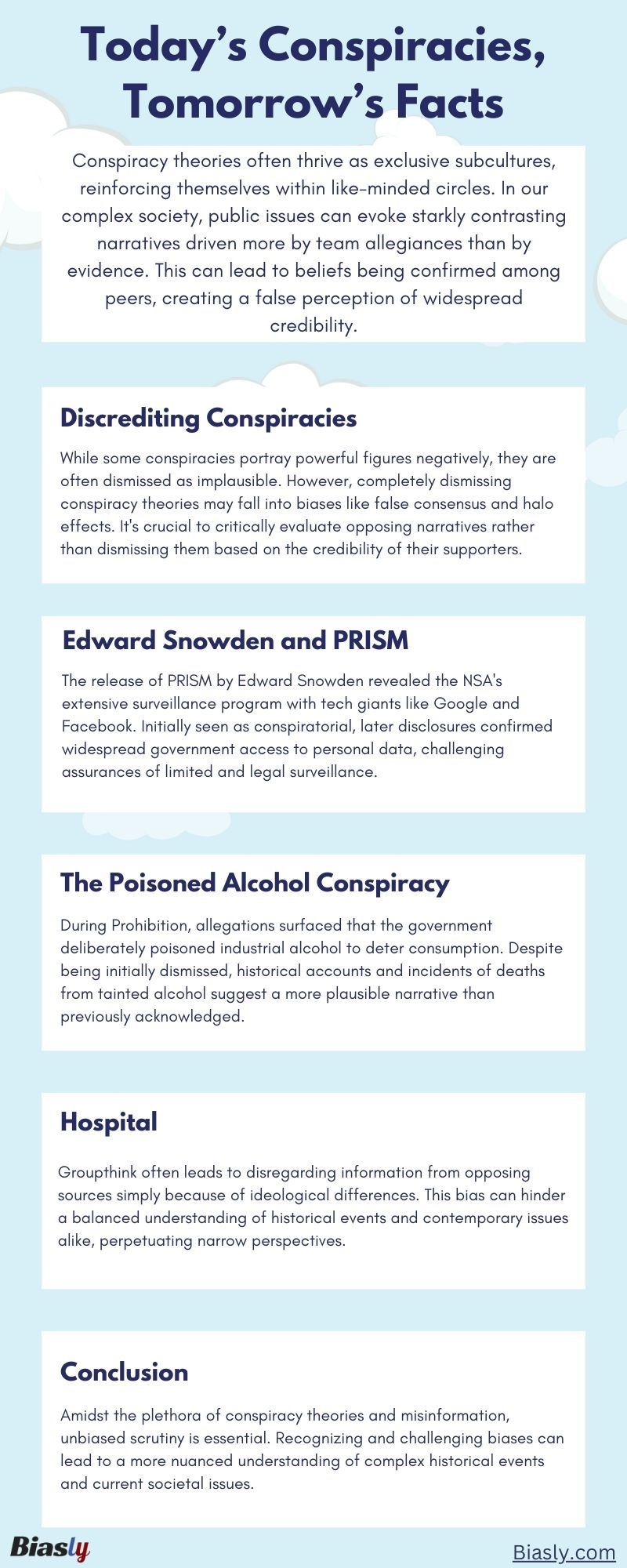
People often consider conspiracy theories a sub-culture that is exclusive and self-feeding. It is reasonable to have drastically contrasting narratives over public issues in our society, especially considering its convoluted nation. Sometimes we evaluate issues not by supporting evidence and rational judgment but by who we identify as teammates. As a result, we could tend to confirm our beliefs amongst like-minded individuals, falsely creating a common belief that the theory is credible to more audiences than reality. Sometimes, conspiracies that categorically interpret people of power and position as mal-intended could be popularly crazy. Discrediting conspiracies is thus often plausible, but dismissing conspiracy theories altogether might have fallen into the same cognitive trap: false consensus bias and halo effect bias. Instead of considering properly the plausibility of narratives we disagree with, we judge issues by judging the credibility of supporters; and falsely estimate that conspiracy-flavored theories aren’t often accepted among anti-conspiracy people. Distancing our identities from a typical conspiracy theorist, we might have falsely discredited their insights altogether. This article lists a few examples where once-discredited conspiracies turn out to be plausible portrayals of reality.
“Big Brother is watching you.”
Edward Snowden’s shocking and courageous release of the government secrets project PRISM (Photo-Refractive Information Storage Material) marks US’s most recent national scandal. Before the evidence was presented to the public, the narrative strokes one as already quite conspiratorial: It told the public that the Obama administration was operating a mass-scale surveillance program in cooperation with mega tech companies.
On June 6th, 2013, The Guardian and The Washington Post reported that the NSA (National Security Agency) has “direct access” to the servers of Google, Facebook, and others, based on the leaked documents. The program practically authorizes the government to access almost all personal information that an individual, once targeted, can offer. Obama claimed that the program was “limited and legal”, which many found to be credible by the general public, not swayed by testimonies from high-office-whistleblowers like William Binney.
Later reports, however, confirmed an era of endangered digital privacy. In 2016, government agencies sent 49,868 requests for user data to Facebook, 27,850 to Google, and 9,076 to Apple, according to the Electronic Frontier Foundation (the EFF). This major nonprofit organization defends civil liberties in the digital world and advises the public on internet privacy matters.
How did the halo effect get in the way?
Despite the anti-terrorist initiative providing credible incentives and licenses for federal agencies to pursue wider surveillance over its citizens, many pro-Democrats discredit this possibility as Republican propaganda. Arguably, Barack Obama’s charisma has created an advantageous halo effect that convinced many of the population that digital surveillance is not an issue of grave concern. And, according to his Biasly rating, he leans between very liberal and moderate, implying that he is sometimes willing to negotiate with the other party.
“Death solves all problems.”
One of the most astonishing and well-discussed conspiracies is the federal government’s alleged “poisoning” of alcohol during the prohibition. The legend goes that the state intentionally ordered a filtration of poisonous substances in the products to curb alcohol consumption. This information is considered a conspiracy for its constant association with anti-vaccination campaigns in 2020. However, this information, motivated by a problematic intention, is a plausible reading of the prohibition history.
According to a TIME report, 41 people died at New York’s Bellevue Hospital from alcohol-related poisonings on New Year’s Eve, 1927. According to the conspiracy theory, these people obtained industrial alcohol from the unregulated black market, a source the federal government instructed to filtrate toxic additives intentionally. This controversial decision is motivated by a limited enforcement power to curb alcohol-related crimes, adding to the claimant’s credibility.
How groupthink leads you on the wrong track
It is easy to dismiss ‘other people’s information as a questionable source altogether simply because they are not ‘my people’ as can be seen in the alcohol conspiracy theory being retold in 2020. Though the federal alcoholic conspiracy might lose its time sensitivity as a historical anecdote, our present reaction to it can loom large as it sheds light on our typical mindset. Though it is reasonable to receive factual information from people you typically agree with, you might learn and improve your understanding of the world from people you usually disagree with.
Conclusion
In this age of misinformation, every individual blogger can have an idiosyncratic insight into our political life. On top of that, these overwhelmingly various conspiracy theories are often associated with particular agendas by specific interest groups. Biasly is a media bias website that pursues no agenda other than providing its readers a credible information shortcut to consume news. Though the truth is hard to find, we can sort out more plausible approaches to access it.























